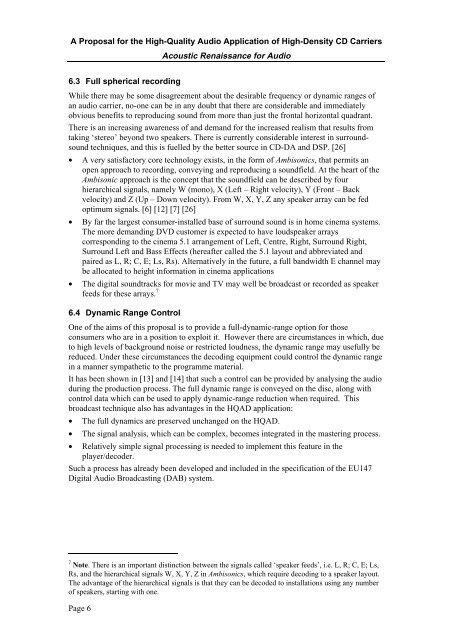A Proposal for the High-Quality Audio Application of High ... - Meridian
A Proposal for the High-Quality Audio Application of High ... - Meridian
A Proposal for the High-Quality Audio Application of High ... - Meridian
You also want an ePaper? Increase the reach of your titles
YUMPU automatically turns print PDFs into web optimized ePapers that Google loves.
A <strong>Proposal</strong> <strong>for</strong> <strong>the</strong> <strong>High</strong>-<strong>Quality</strong> <strong>Audio</strong> <strong>Application</strong> <strong>of</strong> <strong>High</strong>-Density CD Carriers<br />
Page 6<br />
Acoustic Renaissance <strong>for</strong> <strong>Audio</strong><br />
6.3 Full spherical recording<br />
While <strong>the</strong>re may be some disagreement about <strong>the</strong> desirable frequency or dynamic ranges <strong>of</strong><br />
an audio carrier, no-one can be in any doubt that <strong>the</strong>re are considerable and immediately<br />
obvious benefits to reproducing sound from more than just <strong>the</strong> frontal horizontal quadrant.<br />
There is an increasing awareness <strong>of</strong> and demand <strong>for</strong> <strong>the</strong> increased realism that results from<br />
taking ‘stereo’ beyond two speakers. There is currently considerable interest in surroundsound<br />
techniques, and this is fuelled by <strong>the</strong> better source in CD-DA and DSP. [26]<br />
• A very satisfactory core technology exists, in <strong>the</strong> <strong>for</strong>m <strong>of</strong> Ambisonics, that permits an<br />
open approach to recording, conveying and reproducing a soundfield. At <strong>the</strong> heart <strong>of</strong> <strong>the</strong><br />
Ambisonic approach is <strong>the</strong> concept that <strong>the</strong> soundfield can be described by four<br />
hierarchical signals, namely W (mono), X (Left – Right velocity), Y (Front – Back<br />
velocity) and Z (Up – Down velocity). From W, X, Y, Z any speaker array can be fed<br />
optimum signals. [6] [12] [7] [26]<br />
• By far <strong>the</strong> largest consumer-installed base <strong>of</strong> surround sound is in home cinema systems.<br />
The more demanding DVD customer is expected to have loudspeaker arrays<br />
corresponding to <strong>the</strong> cinema 5.1 arrangement <strong>of</strong> Left, Centre, Right, Surround Right,<br />
Surround Left and Bass Effects (hereafter called <strong>the</strong> 5.1 layout and abbreviated and<br />
paired as L, R; C, E; Ls, Rs). Alternatively in <strong>the</strong> future, a full bandwidth E channel may<br />
be allocated to height in<strong>for</strong>mation in cinema applications<br />
• The digital soundtracks <strong>for</strong> movie and TV may well be broadcast or recorded as speaker<br />
feeds <strong>for</strong> <strong>the</strong>se arrays. 7<br />
6.4 Dynamic Range Control<br />
One <strong>of</strong> <strong>the</strong> aims <strong>of</strong> this proposal is to provide a full-dynamic-range option <strong>for</strong> those<br />
consumers who are in a position to exploit it. However <strong>the</strong>re are circumstances in which, due<br />
to high levels <strong>of</strong> background noise or restricted loudness, <strong>the</strong> dynamic range may usefully be<br />
reduced. Under <strong>the</strong>se circumstances <strong>the</strong> decoding equipment could control <strong>the</strong> dynamic range<br />
in a manner sympa<strong>the</strong>tic to <strong>the</strong> programme material.<br />
It has been shown in [13] and [14] that such a control can be provided by analysing <strong>the</strong> audio<br />
during <strong>the</strong> production process. The full dynamic range is conveyed on <strong>the</strong> disc, along with<br />
control data which can be used to apply dynamic-range reduction when required. This<br />
broadcast technique also has advantages in <strong>the</strong> HQAD application:<br />
• The full dynamics are preserved unchanged on <strong>the</strong> HQAD.<br />
• The signal analysis, which can be complex, becomes integrated in <strong>the</strong> mastering process.<br />
• Relatively simple signal processing is needed to implement this feature in <strong>the</strong><br />
player/decoder.<br />
Such a process has already been developed and included in <strong>the</strong> specification <strong>of</strong> <strong>the</strong> EU147<br />
Digital <strong>Audio</strong> Broadcasting (DAB) system.<br />
7 Note. There is an important distinction between <strong>the</strong> signals called ‘speaker feeds’, i.e. L, R; C, E; Ls,<br />
Rs, and <strong>the</strong> hierarchical signals W, X, Y, Z in Ambisonics, which require decoding to a speaker layout.<br />
The advantage <strong>of</strong> <strong>the</strong> hierarchical signals is that <strong>the</strong>y can be decoded to installations using any number<br />
<strong>of</strong> speakers, starting with one.


